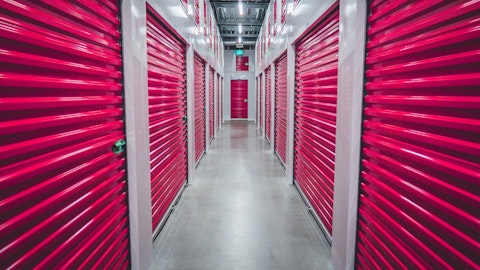And we did have some storm damage that carried through into the third quarter. And on top of that, we’ve had some smart rent installations that we’ve accelerated that added on top of that. So, we expect that next year, we’ll be back more in a normalized spend rate. And again, it doesn’t relate to any accounting changes.
Josh Dennerlein : Okay. Great. Appreciate that color. And then I wanted to just explore the cadence of lease rate growth through October, I guess, particular the new. Was there — as October was progressing, was there like a big drop off towards the tail end of the month? And then if there was, were you kind of doing that in response to maintaining occupancy? Or just kind of what’s the dynamic playing out?
Michael Manelis : Josh, this is Michael. I think I would back you up a little bit and say it’s probably like that third week in September. And again, you’re hitting a period of time which you see seasonal softening. So, it is not uncommon to see demand start to soften. And what we saw in that kind of later part of September specifically in the San Francisco and Seattle market, as things were trailing off, you clearly saw a market react very quickly with concessions increasing and rates coming down to basically get enough demand to hold occupancies. And that has manifested itself throughout the month of October with continuing deceleration, but it’s not like the deceleration has been even more rapid through October. I would tell you it’s kind of been at this level now for a while, but we do expect rates to keep decelerating a little bit.
But the demand right now in those markets needs to be stronger in order to stop the deceleration rate. And we’re just — we don’t have anything that would suggest that we should model that way right now.
Operator: We’ll go next to Michael Goldsmith with UBS.
Michael Goldsmith: Good morning. Thanks for taking my question. We’ve seen new lease rate growth fall quite a bit faster than renewal rate. So how long can the gap remain wide? And are renewing residents more aware of pricing and pushing back harder on renewals? Or are they just accepting the rent increase? Thanks.
Michael Manelis : Yes. Michael, this is Michael. So, we are negotiating a little bit more, but again, that’s not uncommon to do in the fourth quarter of any year. We have quotes out for the next 90 days. I think our residents are clearly aware of what’s happening in the marketplace. You definitely have kind of more conversations being — taking place within our centralized renewal team. We’re negotiating. We have quotes out somewhere in that kind of mid-7% range, and we expect to achieve somewhere around the 5%, maybe it’s like low 7s to mid-7 depending on the month that we have out there. But we have a lot of confidence that the spread you’re seeing is not uncommon to see in the fourth quarter. If new lease rates typically go negative, our renewals typically hold up in that 4% to 5% range.
So, I don’t really see anything that suggests that the spread is not going to continue as we see it. And then as we turn the year, again, it’s really more of a function of what happens with intra-period rate growth. But as you start the year off, you’ll see us start tightening up some of the renewal negotiations, but we expect a lot of stability on that renewal front. And what we’re still trying to figure out is how to peg that new lease change assumption for the year.
Michael Goldsmith: That makes sense. And my second question is, in this environment, how do you think about your relationship with Toll Brothers? Is there a greater opportunity to push harder and deliver units into a more favorable supply environment in the expansion markets? And then along with that, have you changed your acquired yields on development? Thanks.
Mark Parrell: I’m going to split that in half and talk about Toll. It’s Mark and I’m going to ask Alex to speak to our required hurdle rates on development. So, we have a great relationship with the folks at Toll. They see the same thing we do, that there’s a need to moderate development in some of these markets. We have three deals delivering. One of them, we move forward a couple of quarters. I mean their — Toll is everything we thought they were. They’re an expert developer builder. They’re doing a great job. Obviously, we’re going to face those same supply issues in Dallas that everybody else is when these 3 assets get up and running. So, I’m not sure why we delay anything. I’m getting the asset up and running getting heads and beds, getting income, that’s in our in the shareholders’ best interest.
So that’s what we’ll do. And we’re just — we’re assuming that starting at the beginning of next year, middle of next year, we’ll have all three of those development deals in the lease-up process. And we’ll report back. But I wouldn’t delay any of those. If you’re talking about other starts with Toll and anyone else, that goes more to Alex response on hurdle rates.
Alexander Brackenridge: Yes. And I think — it’s Alex. With the 10-year in the high 4s, you think cap rates have got to be in the high 5s. And you think that development yields have got to be mid-6s or high 6s. So, the challenge right now is just getting a project to underwrite with that hurdle. Construction costs are not going up like they used to, but they’re not going dramatically down and rents are not booming. So, it’s very hard to get to a number that underwrites and Toll understands that and so do our other potential partners and ourselves as we look at projects we might do on our own or with partners, it just very, very difficult to make the numbers work.
Michael Manelis : But I want to interject one thing because there are a couple of development deals we’re looking at now that we like, that are in markets in the Northeast. And the thing that really distinguishes them is the really hard places to buy. So, we look at these assets, they have the benefit of having certain zoning and electrical codes and other things that are beneficial. It might be to start that deal or start one or two of these deals, but we’re being super selective. We haven’t started anything this year. But we do have instances like that where there’s an opportunity to build somewhere that you really can’t buy in and where we like that exposure where we might be willing to move forward even if it isn’t really high 6%, mid-6% return, but the return and the sort of overall IRR in the long haul makes some sense. So yet to come on that, but I do want to put that out there.
Michael Goldsmith: Thank you, very much.
Operator: We’ll go next to John Kim with BMO Capital Markets.
John Kim : Thank you. I wanted to ask about Seattle and your comments today that seems like it’s more of a demand issue and a lack of job growth versus last quarter, where I think you cited it was more of a supply risk and there was a lot of optimism on the Amazon return office. So, I guess my question is, has that Amazon pull faded and maybe disappointed as far as drawing in employees and some of the peers? And when do you expect the supply to peak in Downtown Seattle?
Michael Manelis : John, this is Michael. So, I think last quarter, what you heard us speaking to is with Amazon’s return to the office mandate, you did see South Lake Union’s occupancy tick up. You saw the demand pick up. It wasn’t in migration from outside the MSA, it was just pulling people back in from further out within the MSA into that specific area. And in South Lake Union, we did have some new lease-ups. Those lease-ups did feel like they were getting kind of their application volume through. So, you saw concession use really kind of pull back a little bit or stay stable. So, the pressure we felt was a little bit less in that specific area. If you fast forward into next year, Seattle is going to have elevated supply, and that supply is going to be concentrated in the city of Seattle, and we are going to feel that specifically in like a micro submarket of like Downtown Redmond where we happen to have six properties, five of which are really a product that will compete head-to-head with that supply.
So, in terms of like how to think about when that pressure is coming to us next year, I don’t have the breakout for the new leasing stats by quarter. But I do know that it’s not like Q1 is not when we’re expecting to feel it. I think we have a little bit of a ramp-up period, but we do expect outside pressure in that market.



